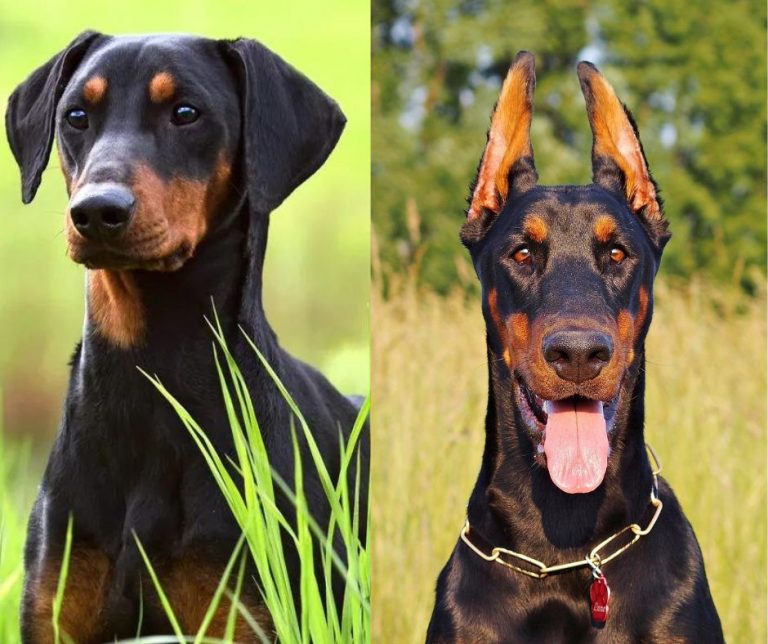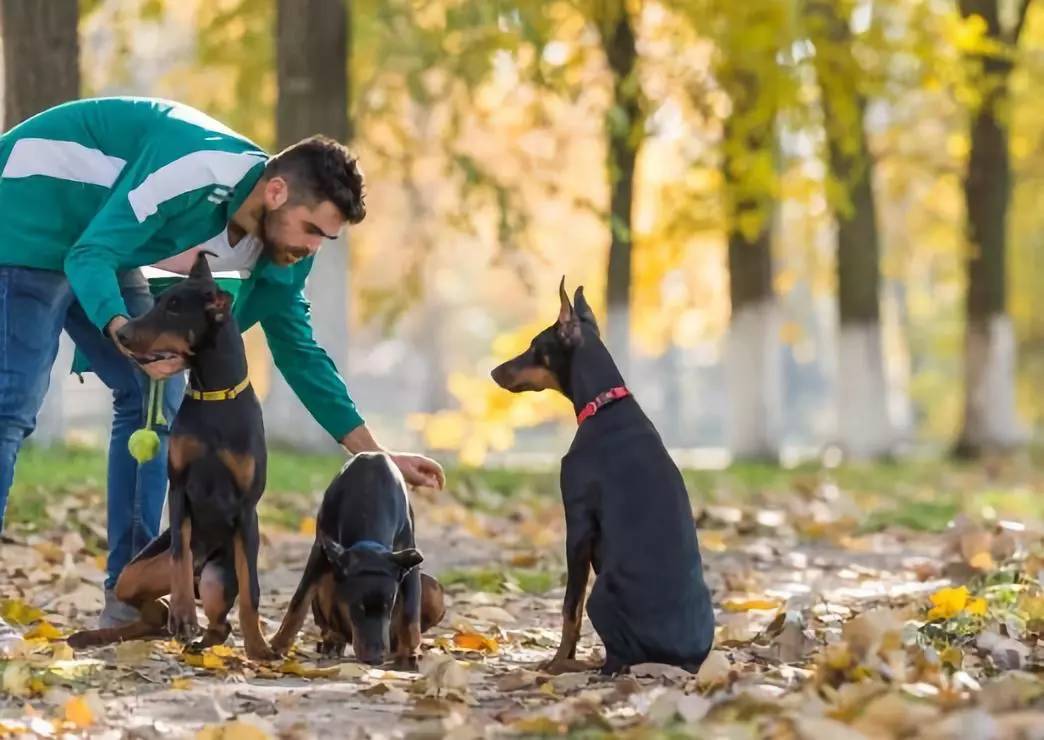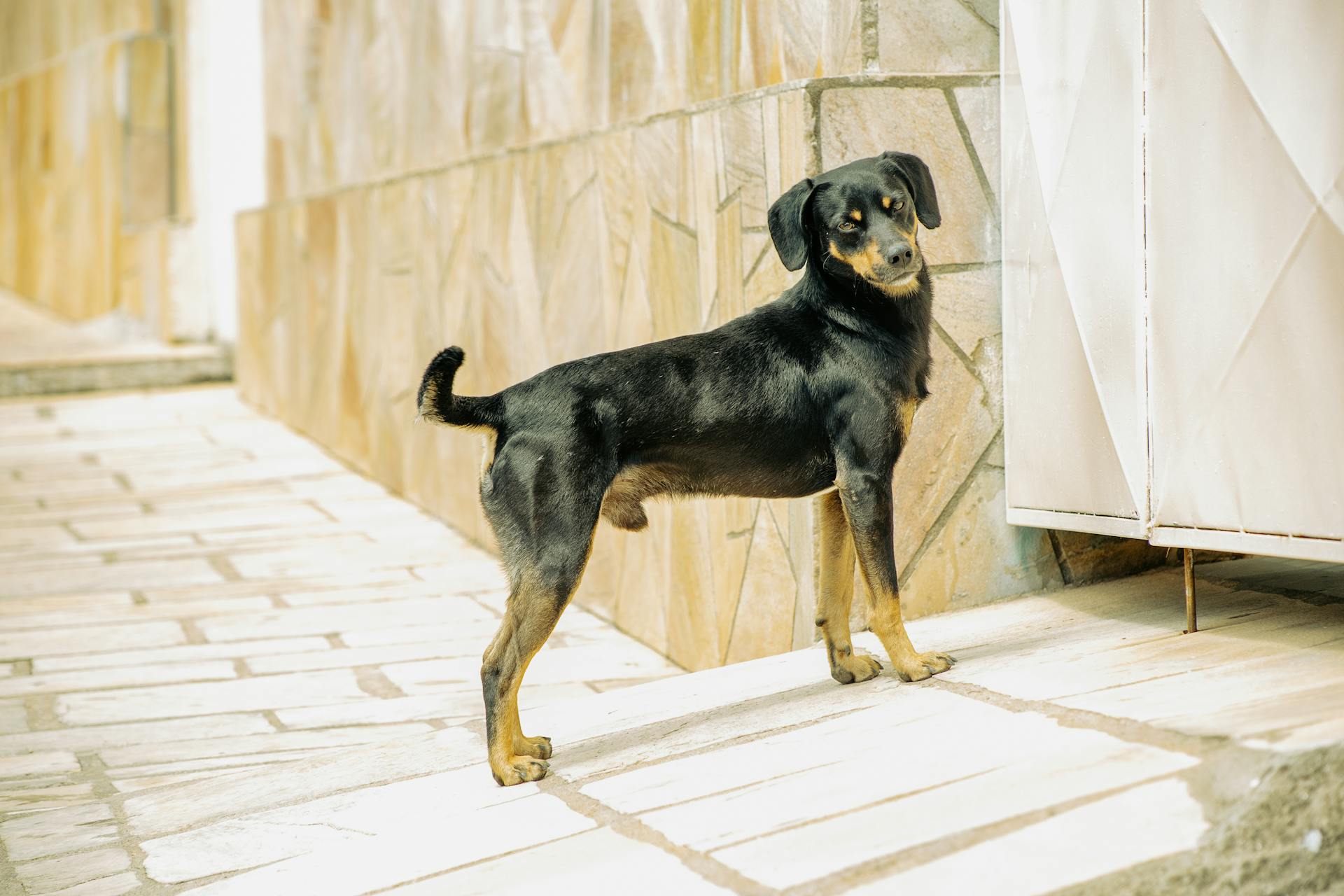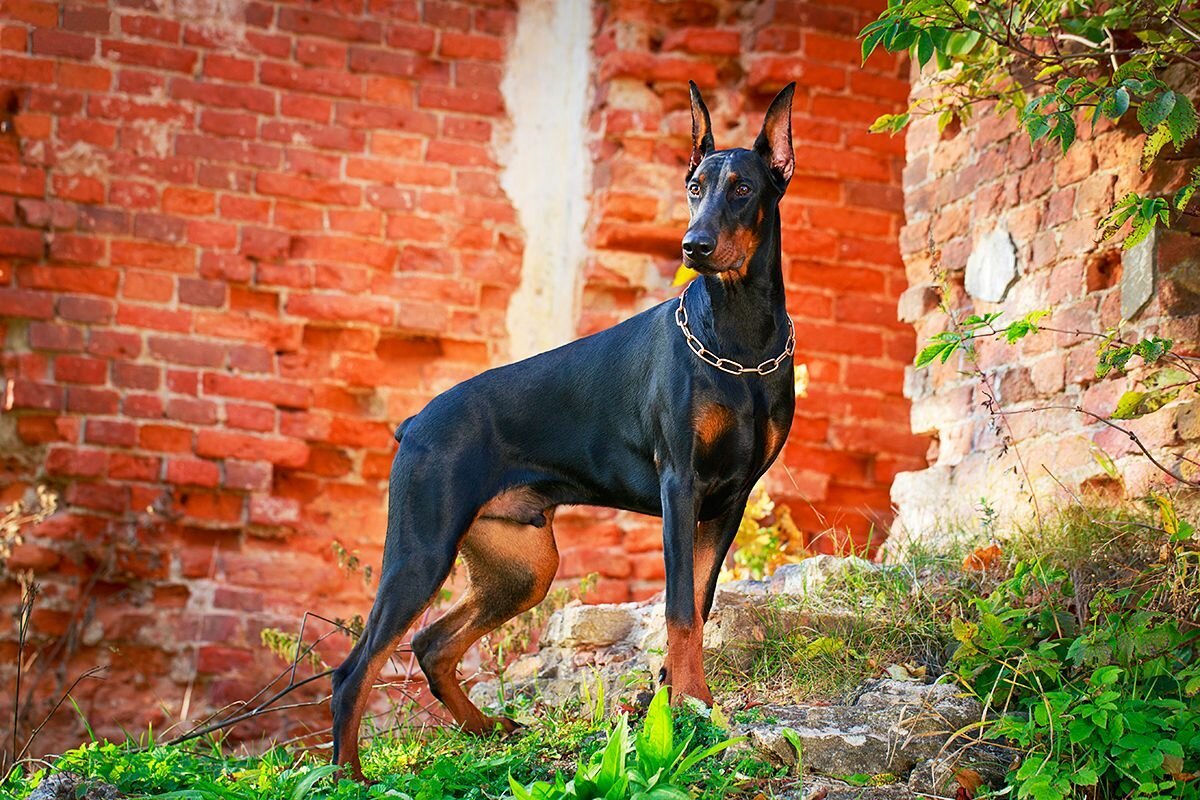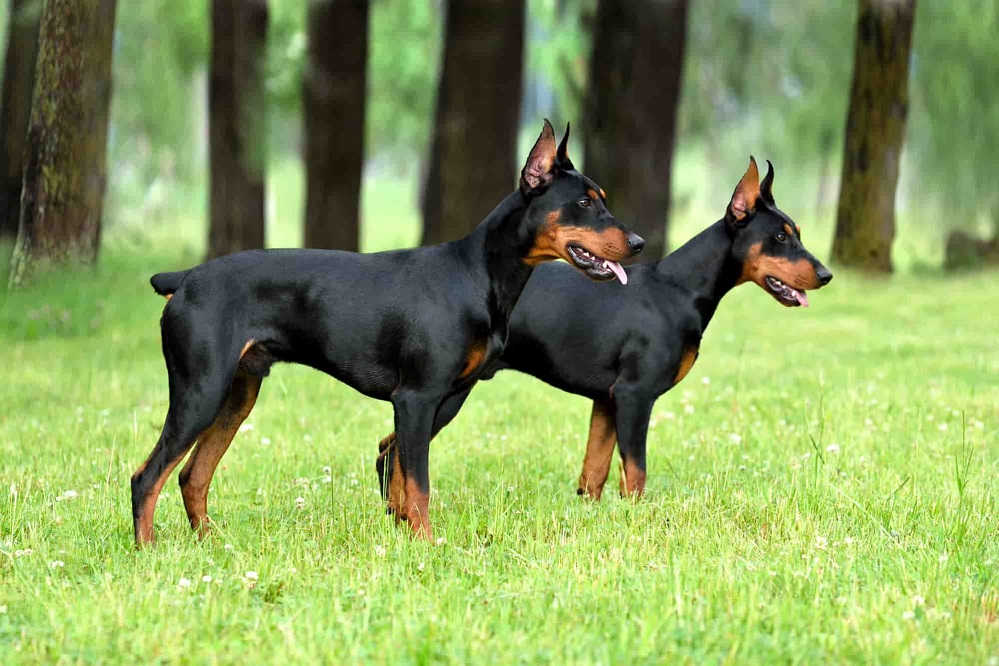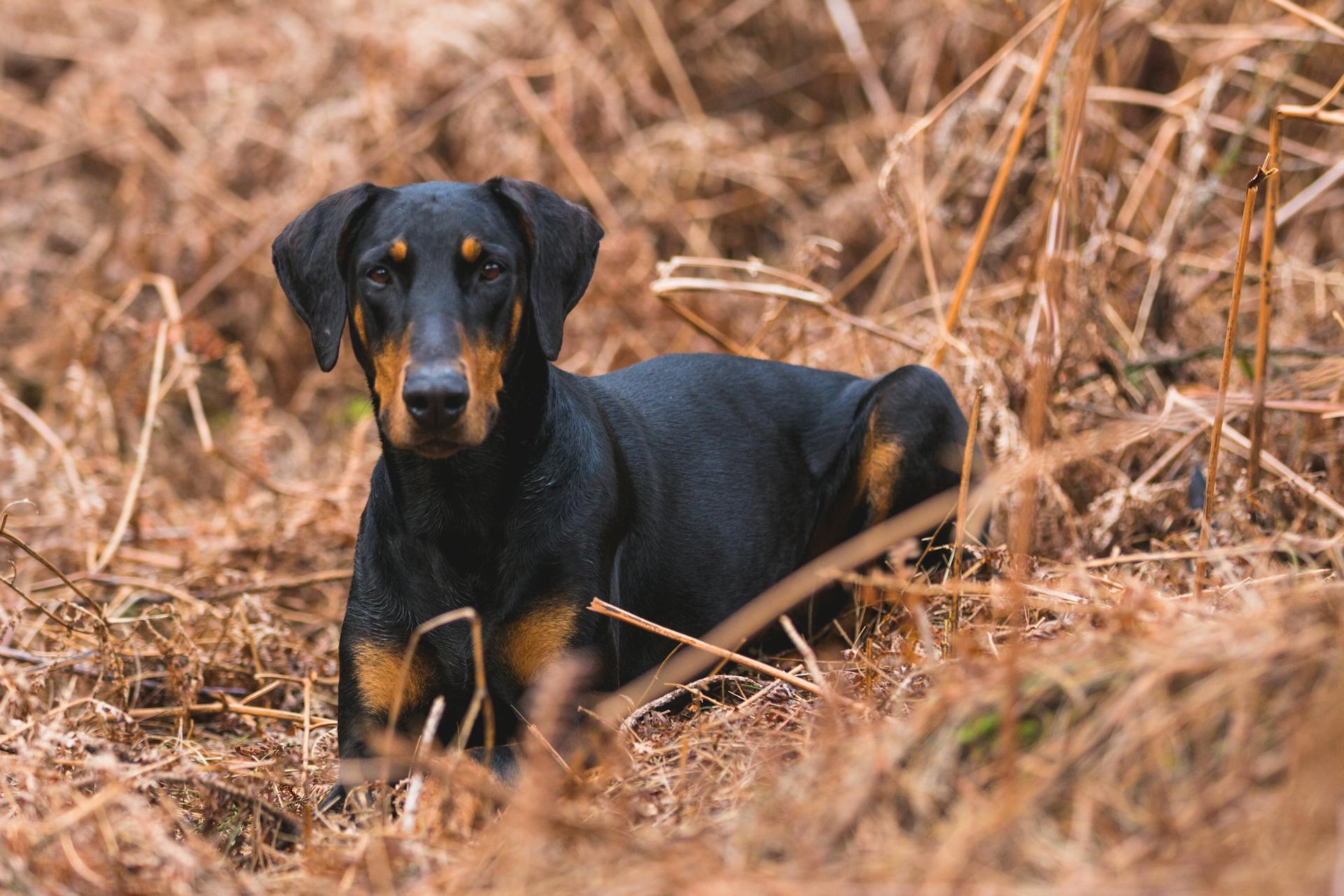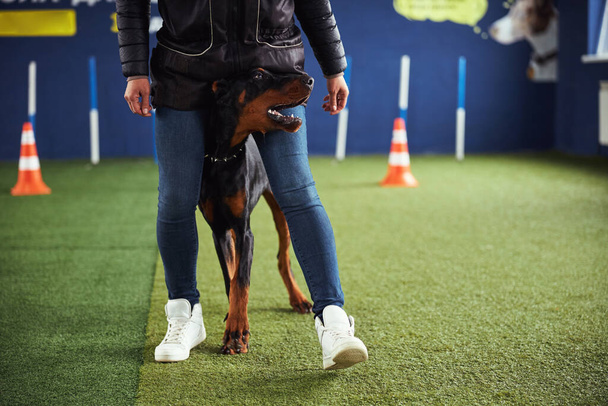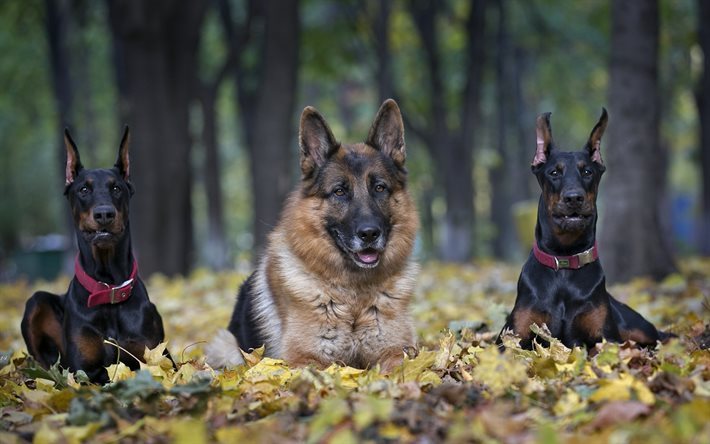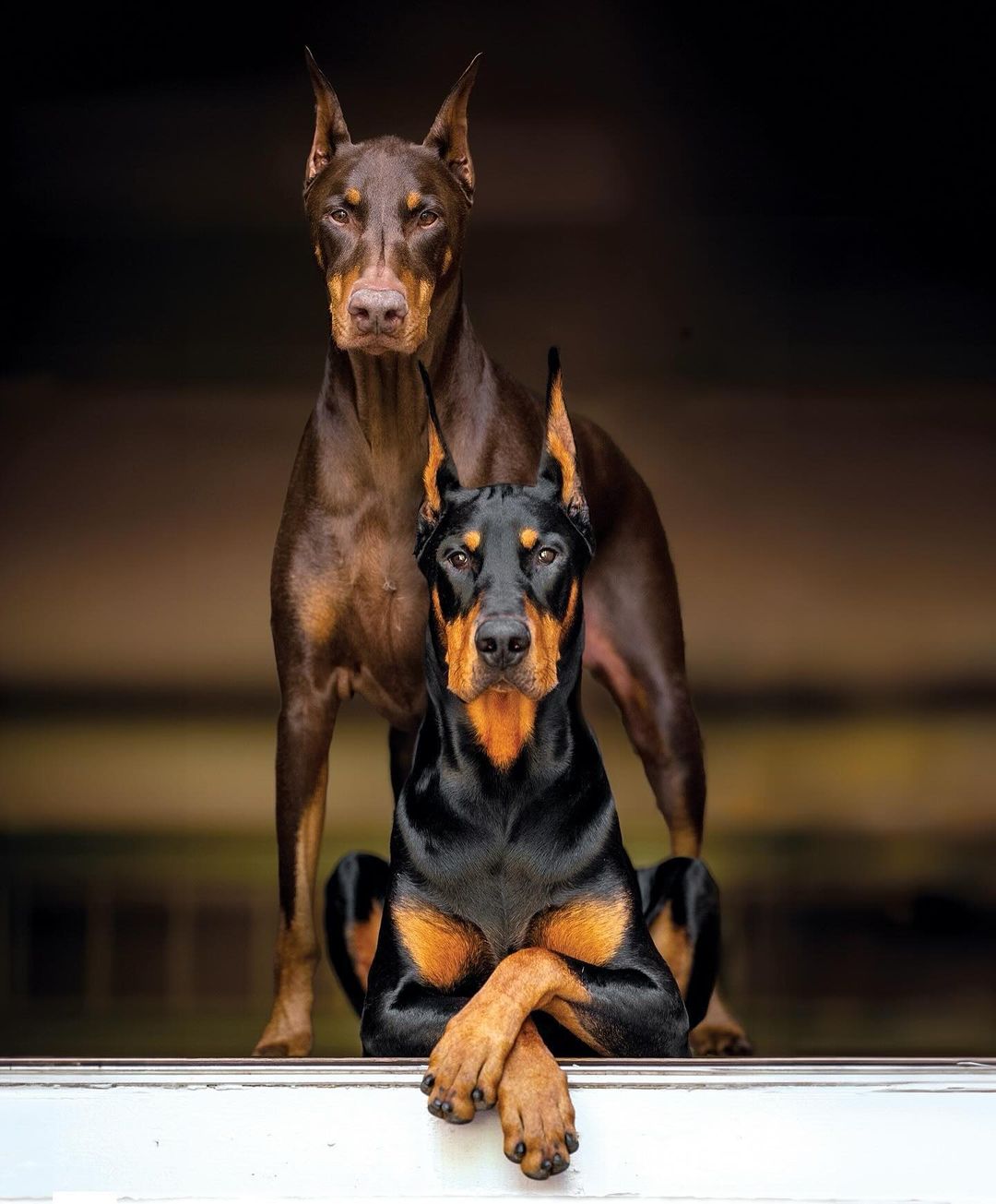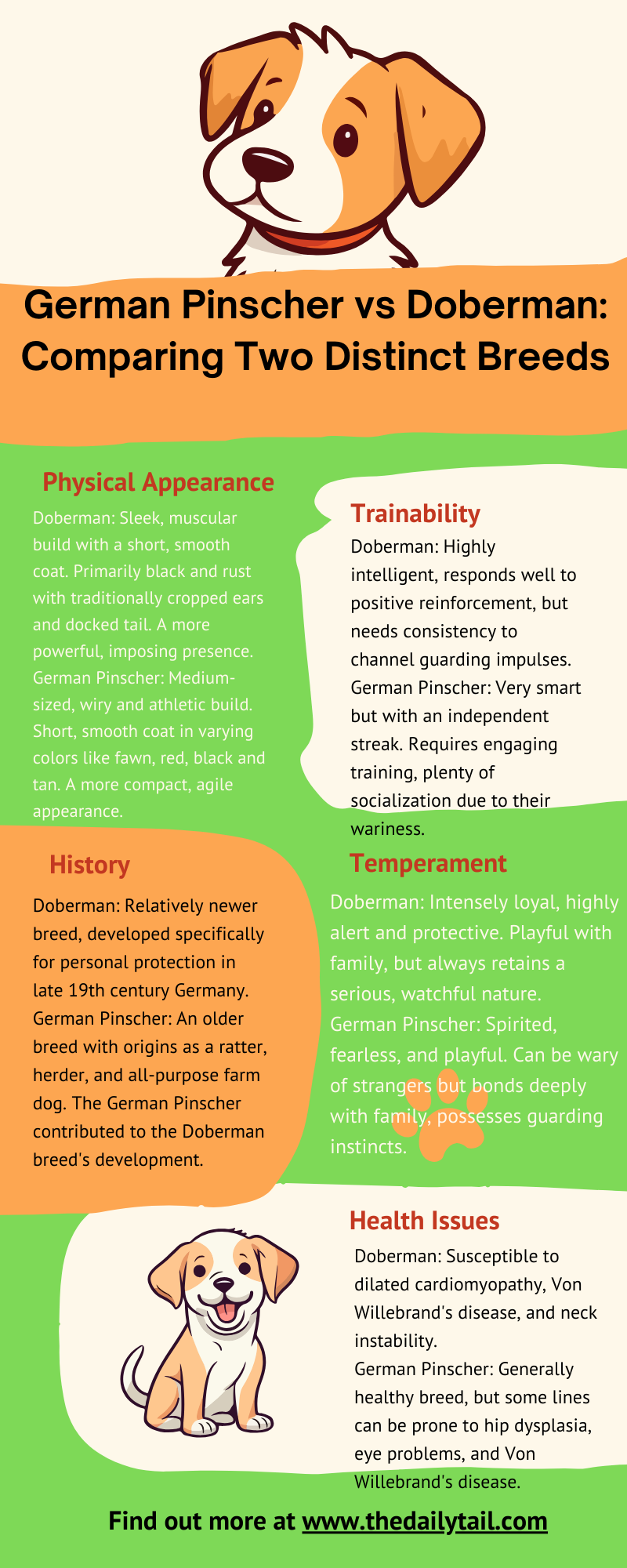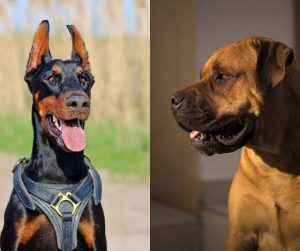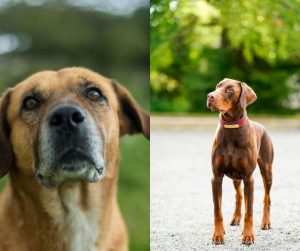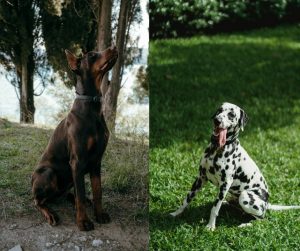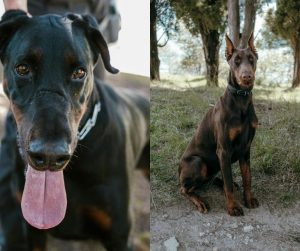Having lived with sleek protectors and spirited companions, I find the Doberman and German Pinscher offer surprisingly unique journeys. Let’s delve into what sets them apart.
The German Pinscher and the Doberman are two distinct breeds that are often compared due to their similar lineage and the roles they have come to embody in the canine world. Both breeds share a reputation for intelligence, loyalty, and a protective nature, traits that make them excellent companions and watchdogs. Despite their shared qualities, they are separate breeds with unique characteristics that distinguish them from each other.
One notable difference between the German Pinscher and the Doberman lies in their size. The German Pinscher is the smaller of the two, generally standing between 17 to 20 inches tall and weighing around 25 to 45 pounds. In contrast, the Doberman boasts a larger frame, standing 24 to 28 inches tall and weighing between 60 to 100 pounds.
This size disparity not only affects their physical presence but also plays a role in their health and lifespan, with the smaller German Pinscher typically enjoying a slightly longer average lifespan than the Doberman.
Developed for different purposes, the German Pinscher and the Doberman have adapted their physical and behavioral attributes to their historical roles. The German Pinscher, originally bred for ratting and as a versatile farm dog, has a compact, muscular frame fitting for various tasks. On the other hand, Dobermans were specifically bred to be larger personal protection dogs, with a commanding presence and high trainability that suited their roles in police and military work. The differences in their lineage and design contribute significantly to their respective temperaments and abilities.
Today, we will look at the German Pincher vs Doberman Pincher breed comparison.
Breed Origins and History
Distinctly different yet stemming from a common heritage, German Pinschers and Doberman Pinschers have histories rich in function and purpose, rooted in Germany during earlier centuries.
German Pinscher Origins
The German Pinscher puppy, known for its vermin hunting capabilities, has its origins in Germany dating back to the 17th century, although it was first officially recorded in 1885. They were developed primarily for their performance as working dogs with proficiency in tasks like guarding and herding.
- First Records: 1885, Germany
- Primary Role: Versatile working dog; vermin eradication, guarding, herding
Doberman Pinscher Origins
The Doberman Pinscher was cultivated by a German tax collector named Karl Friedrich Louis Dobermann in the late 19th century. He aimed to breed an alert, loyal, and protective dog to accompany him during his collection rounds for safety reasons. The breed is a result of several crossbreedings, specifically to enhance these traits for protection. Nowadays, people make a difference between an European Doberman and American Doberman.
- Creator: Karl Friedrich Louis Dobermann
- Profession: Tax Collector
- Breeding Purpose: Personal protection and companionship during collection duties
- Time Period: Late 1800s
Physical Characteristics
When comparing the German Pinscher vs Doberman, one can observe distinct differences in their physical characteristics. These differences are evident in their size and structure, coat and color, and other distinctive features.
Size and Structure
The German Pinscher and Doberman differ notably in size. German Pinschers are medium-sized dogs with a strong, square build. They typically stand between 17-20 inches in height and weigh around 24-45 pounds. In contrast, Dobermans are larger, with a muscular stature and a more robust presence. They usually stand 24-28 inches tall at the shoulder and weigh between 60-100 pounds.
- German Pinscher: 17-20 inches, 24-45 pounds
- Doberman: 24-28 inches, 60-100 pounds
Coat and Color
Both breeds possess a short coat that is smooth and easy to groom. However, their coloration shows variety within and between the breeds. German Pinschers can be found in a wider range of colors, including reds, blues, and a mix of blacks and tans. Dobermans typically display a more limited color palette, with the most common colors being black, red, blue, and fawn, all with rust markings.
- German Pinscher: Reds, blues, blacks, tans
- Doberman: Black, red, blue, fawn (usually with rust markings)
Distinctive Features
The physical appearance of the German Pinscher and the Doberman is similar, yet they possess certain distinctive features. German Pinschers have high-set, folded ears and a poised tail, which may be docked in some regions. Dobermans often have a sharper, more pronounced wedge-shaped head, and it is common for them to have cropped ears and docked tails, giving them a more alert and powerful silhouette.
- German Pinscher: High-set folded ears, poised tail
- Doberman: Wedge-shaped head, cropped ears, docked tail
German Pincher vs Doberman Temperament and Behavior
When comparing the German Pinscher and the Doberman, differences are evident in their temperaments and behaviors. Both breeds display high energy levels, strong protective instincts, and innate loyalty, but they showcase these traits in different ways.
General Temperament
German Pinscher:
- Energetic and Active: They are known for their high energy and need for regular exercise
- Alert: German Pinschers are always on the lookout, which makes them excellent guard dogs
- Loyalty: They tend to form strong bonds with their families and can be affectionate with those they trust
Doberman:
- Protective: Dobermans are inherently protective, which is a hallmark of their character when it comes to their family
- Loyal Companions: Their loyalty is profound, often called velcro dogs because of their desire to stay close to their owners
- Temperament: While they are also active and energetic, Dobermans may require more mental stimulation to match their intelligent nature
Behavioral Traits
German Pinscher:
- Prey Drive: Possessing a strong instinct, they can sometimes give chase to smaller animals due to their prey drive
- Behavioral Variability: Their behavior can be shaped significantly by early training and socialization
Doberman:
- Disciplined: Known for their trainable character, Dobermans excel in obedience with the right guidance, reflecting a disciplined behavior
- Alert and Responsive: As working dogs, they are highly alert and responsive to their environment, which serves well in protection roles
Health and Lifespan
When comparing the health and lifespan of the German Pinscher and the Doberman, it’s essential to consider the common health issues they may face, as well as their respective life expectancy. Understanding these factors can help prospective owners to prepare for their pet’s long-term well-being.
Common Health Issues
German Pinscher:
- Hip Dysplasia: A genetic condition where the hip joint doesn’t fit neatly into the hip socket, causing pain and arthritis
- Von Willebrand’s Disease: A bleeding disorder caused by a deficiency of the von Willebrand factor, which helps blood to clot
- Progressive Retinal Atrophy (PRA): A degenerative eye disorder that can lead to blindness due to loss of photoreceptors at the back of the eyes
Doberman:
- Cardiomyopathy: A disease of the heart muscle that can lead to heart failure
- Hip Dysplasia: Dobermans are also susceptible to hip dysplasia, like the German Pinscher dog breed
- Von Willebrand’s Disease: This disease is common in Dobermans as well, affecting their ability to clot blood
Expected Lifespan
- German Pinscher: They typically have a lifespan of 11-12 years
- Doberman: They generally live for 10-11 years
Both breeds benefit from regular health checks to monitor for these conditions and may enjoy a full lifespan with proper care.
German Pincher vs Doberman Training and Exercise Needs
The German Pinscher and Doberman are both breeds with high training and exercise needs, requiring consistent obedience training and ample daily physical activity for their well-being.
Training Techniques
When training both German Pinschers and Dobermans, it’s crucial to harness their intelligence and eagerness with positive reinforcement. These breeds respond well to consistency and clear commands, making obedience training a suitable approach. For effective training:
- Positive reinforcement is key: Utilize treats, praise, and play to reward good behavior
- Consistency is crucial: Regular training sessions will help reinforce learned commands
- Early socialization: Exposing them to various people, pets, and environments can prevent behavioral issues
Exercise Requirements
Regarding exercise, both breeds have robust needs to stay healthy, both mentally and physically. Specifics are:
- German Pinschers need around 1-2 hours of physical activity per day, including playtime for mental stimulation
- Dobermans generally require about 2 hours of exercise daily to cater to their higher energy levels
To break down exercise needs:
| Breed | Exercise Needs | Mental Stimulation |
|---|---|---|
| German Pinscher | Moderate: 1-2 hours/day | Playtime & training for engagement |
| Doberman | High: 2 hours/day minimum | Rigorous play & advanced training |
Regular exercise should incorporate runs, walks, and interactive play. Adequate mental and physical stimulation will mitigate potential behavioral issues and ensure the health and happiness of these intelligent breeds.
Care and Grooming
When it comes to care and grooming, both German Pinschers and Dobermans have similar needs due to their short coat length. They require regular grooming but are relatively low maintenance compared to long-haired breeds.
Grooming Essentials
German Pinschers and Dobermans boast short, smooth coats that shed moderately. Regular brushing helps to minimize shedding and maintain a healthy coat.
- Brushing: Utilize a firm bristle brush once or twice a week
- Bathing: Bath only when necessary to avoid drying out their skin
Owners should also heed the following grooming tasks:
- Nail Trimming: Monthly to prevent overgrowth and splitting
- Ear Cleaning: Check and clean as needed to prevent wax buildup and infection
- Teeth Brushing: Several times a week to promote oral health
Daily Care
The daily care for a German Pinscher and a Doberman extends beyond merely grooming their hair.
- Physical Activity: They demand daily exercise to stay healthy and mitigate potential behavioral issues
- Mental Stimulation: Interactive play and training sessions should be part of their routine to keep them mentally sharp
It’s important to inspect the dogs’ coats during daily activities for any signs of infection, parasites, or skin issues and to maintain a veterinary care schedule.
Suitability as a Pet
When considering a German Pinscher or Doberman Pinscher as a pet, their compatibility with family life, other animals, and the living environment are important factors. Each breed carries distinct personality traits and care needs that potential owners should evaluate.
With Families
German Pinschers are known for their vibrant and protective nature, which can make them suitable for families. They are generally family-friendly, but because of their spirited temperament, they may be better with older children who can respect a dog’s boundaries. Doberman Pinschers, on the other hand, are affectionate and loyal to their families. Their energy level is compatible with active family lifestyles, although their large size warrants careful interaction with young children to prevent accidental injury.
With Other Pets
Both breeds require socialization from a young age to foster peaceful coexistence with other pets. German Pinschers have a high prey drive and may be better suited to homes where they can be the only pet unless socialized early. Dobermans are often dog-friendly when properly socialized, but due to their size and assertiveness, owners must supervise interactions with other pets, especially smaller ones.
Adaptability to Living Spaces
The adaptability of German Pinschers and Dobermans to various living spaces varies. German Pinschers can adapt to apartment living if they receive sufficient daily exercise, which is crucial given their moderate to high energy level. Dobermans are larger and more active, typically necessitating a home with more space, like a house with a securely fenced yard. Neither breed is suitable for a sedentary lifestyle or confined spaces without regular exercise and mental stimulation.
Role in Human Society
German Pinschers and Dobermans both have a rich history and a significant presence in various roles within human society, serving in capacities that range from guardianship to support services.
Historical Roles
The German Pinscher, originally bred for its proficiency in vermin control, was a versatile farm dog with various responsibilities including guarding property and livestock. Its strong hunting instincts were essential for farmers in maintaining a pest-free environment. The Doberman Pinscher, purposefully bred in the late 19th century by a German tax collector named Karl Friedrich Louis Dobermann, was intended to be a protection dog.
The breed’s intelligence, strength, and loyalty made them a perfect fit for guarding and police work. Dobermans were also utilized as military dogs during wars, their roles including messenger, sentry, and rescue tasks.
Modern Day Roles
Today, both German Pinschers and Dobermans continue to showcase their versatility. German Pinschers still serve as capable watchdogs, while their size and agility allow them to excel in dog sports. Dobermans have a prominent role as police dogs and working dogs due to their intelligence and trainable nature. They are often seen in roles such as:
- Police Work: As part of K-9 units, they track and apprehend suspects and locate drugs and explosives
- Search and Rescue: Due to their keen sense of smell and endurance, they perform effectively in finding missing persons
- Therapy and Support: Their sensitive and loyal nature allows them to provide comfort as therapy dogs
Both breeds share a common utility as loyal working dogs, demonstrating a deep bond and functionality within the many aspects of human life.
Breed Comparisons and Considerations
The distinction between the German Pinscher and the Doberman Pinscher lies in their size, ancestral lines, and suitability for families. This section illuminates the subtle yet important differences between these two medium-sized dog breeds with shared ancestry.
German Pinscher vs Doberman Pinscher
Size:
- German Pinscher: Typically stands 17-20 inches tall, weighing 25-45 pounds
- Doberman Pinscher: Taller, standing 24-28 inches at the shoulder, and heavier, weighing 60 to 80 pounds when fully grown
Temperament:
- Both breeds are known for their intelligence and suitability as family pets. They are strong, energetic, and loyal dogs
- German Pinschers need early socialization and can be assertive and spirited
- Dobermans are often perceived as more protective and may require a firm hand in training due to their larger size and strength
Exercise Needs:
- Both breeds require significant exercise to stay healthy and happy. More than 2+ hours of daily activities are advisable for their mental and physical stimulation.
Lifespan:
- Their lifespans differ marginally, with Dobermans typically living 10-13 years and German Pinschers 12-14 years
Grooming Needs:
- Both breeds have low grooming requirements; they possess short coats that need minimal maintenance
Related Breeds
Miniature Pinscher:
- Related to both the German Pincher dog breed and Doberman Pinscher, the Miniature Pinscher is significantly smaller
- They share similar qualities such as confidence and energy, but in a more compact package, typically standing 10-12.5 inches tall and weighing 8-10 pounds
Ancestry:
- All three breeds share a common ancestry with a history of being versatile working dogs
- Their heredity has given them traits valuable in guard work, police work, and companionship
When comparing the German Pinscher to the Doberman Pinscher, one should consider their living environment, time available for training and exercise, and the presence of children in the household. Both breeds make excellent companions but have distinct needs and characteristics that potential owners should evaluate.
Choosing the Right Breed for You
When selecting between the German Pinscher and the Doberman, potential owners should consider their lifestyle, the traits of each breed, and how these align with their personal preferences and capabilities.
Understanding Your Needs
Before committing to a breed, one must assess their lifestyle. German Pinschers and Dobermans are both energetic and athletic; they thrive in active environments. Prospective owners should be prepared for daily walks, engaging play, and mental stimulation.
Evaluating Breed Traits
German Pinschers and Dobermans both possess a confident and loyal disposition. However, the German Pinscher is a more compact breed, often resulting in fewer health issues and a slightly longer lifespan. In contrast, Dobermans are larger and can appear more intimidating, which may be a factor for those seeking a dog with a strong presence.
| Traits | German Pinscher | Doberman |
|---|---|---|
| Size | Compact | Large |
| Energy Level | High | High |
| Lifespan | 11-12 years | 10-11 years |
| Training | Requires consistency | Needs early socialization |
| Maintenance | Low grooming needs | Low grooming needs |
Decision Factors
Choosing a breed also depends on factors such as the dog’s versatility and ability to cope with puppyhood challenges. The German Pinscher and Doberman are both affectionate with their families, but the former may be a better option for first-time owners due to its manageable size and calmer approach to life. While the Doberman, with its zest and guardian instincts, may present more of a challenge in training and socialization, they are excellent for those prepared to undertake a firm and loving approach to raise a well-behaved pet.

